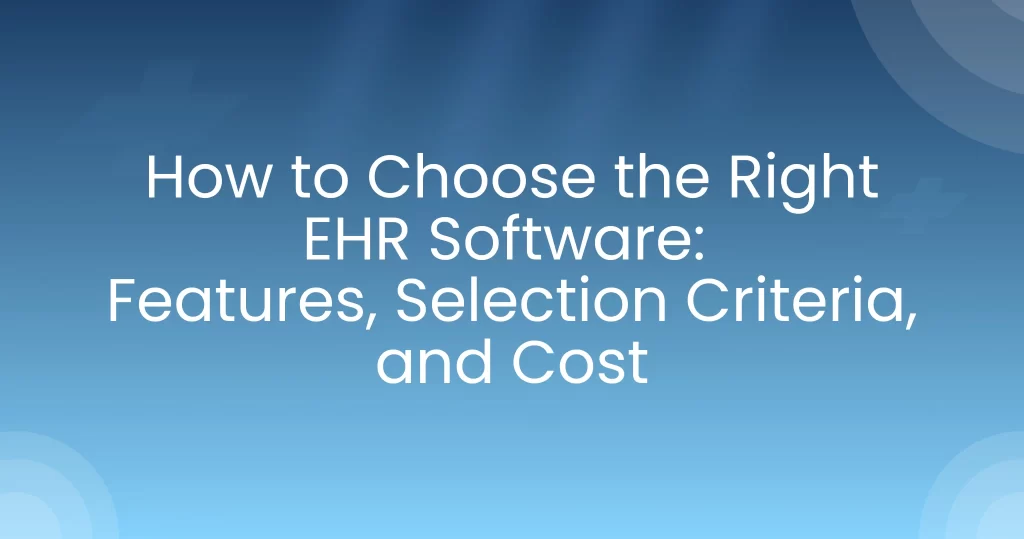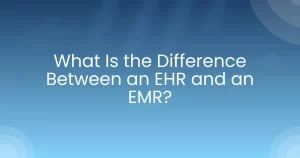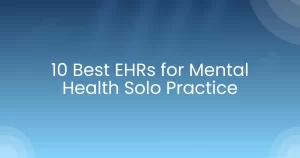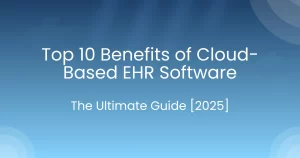The modern medical practice, it is important to know how to select an EHR software. This is a complicated decision, as hundreds of providers compete. Cost, usability, and compliance concerns have remained the highest priorities in choosing an EHR suitable for meeting long-term objectives.
EHR systems influence compliance, patient engagement, clinical care, and billing. A poorly chosen system interrupts workflow and financial load, whereas a carefully chosen one enhances efficiency, patient safety, and provider satisfaction.
This blog explains how to use EHR, highlights its key features, compares EHR systems, discusses selection criteria, and discusses future trends. By the end of this blog, you can make an effective decision for your practice.
What is an EHR System and How Does It Work?
An Electronic Health Record (EHR) system is a compilation of patient medical information in digital format, centralized on one platform. EHRs give a broader view as compared to EMRs, which are focused on clinical charts only.
EHRs contain information such as diagnoses, prescriptions, lab results, and imaging. This data is exchanged among departments/facilities and outside providers, thus making care more interconnected and effective.
EHRs also facilitate compliance. They assist organizations in adhering to HIPAA, HL7, and local healthcare regulations, guaranteeing the privacy of patient data and safe record keeping.
The Benefits of EHR Systems
Here are some of the commendable benefits an EHR system can provide.
1. Centralized Patient Data
Patient records across facilities and providers are standardized with EHRs. All data is not stored in various locations, but is centrally stored, which increases communication between specialists, hospitals, and primary care providers.
2. Improved Patient Safety
EHRs prevent medical errors by monitoring allergies, prescriptions, and previous treatments. E-prescribing is one of the functions that informs providers about the possible negative interactions with the drugs, making the care safe and fast.
3. Compliance Support
Healthcare is a very controlled industry, and the punishment for not following the rules can be excessive. Access controls, audit trails, and encryption fulfill EHR compliance requirements such as HIPAA and HL7.
4. Advanced Analytics
EHRs do not just keep records. With EHR data analytics, practices can measure results, predict demand, and track health trends. Analytics can help improve the health of the population and optimize resources.
5. Operational Efficiency
EHRs are automated, so scheduling, billing, and filing claims will save time and money on paperwork and administration. Employees can also focus more on patients than on paperwork.
6. Better Patient Engagement
Patient portals are also present in EHRs, where a person can view his or her health records, schedules, and refill requests. Such transparency creates trust, and patients are encouraged to participate in their treatment.
7. Interoperability Across Systems
EHRs are designed to provide information to pharmacies, laboratories, and other healthcare providers. This will ease the coordination of care across facilities and deliver improved outcomes.
Key Features Every EHR Software Should Have
The appropriate EHR should be able to assist with clinical, administrative, and advanced requirements. Let’s break these features into categories.
Clinical Features
- E-prescribing: Provides an opportunity to transmit prescriptions to pharmacies electronically.
- Lab integration: Automated lab results importation to accelerate decision-making.
- Patient history: History about allergies, treatments, and medications is documented here.
The features reduce medical errors, improve patient safety, and conserve providers’ time.
Administrative Features
- Scheduling: Process reminders, appointments, and cancellations.
- Billing: Process patient insurance claims and invoices in an automated fashion.
- Documentation: Standardize the note-taking and forms used to reduce paperwork.
Strong administrative instruments will ensure the stability and efficacy of the revenue cycle.
Advanced Features
- EHR data analytics: Monitors health trends and risk prediction.
- Interoperability: Relates to external providers and hospitals.
- Integration of telehealth: Grows virtual care.
These tools reflect the three capabilities of an EHR system, i.e., data capture, data sharing, and sophisticated analytics.
Selection Criteria: How to Choose an EHR System
Choosing an EHR requires a structured evaluation. Practices should use an EHR evaluation checklist for guidance.
Usability and Training
An EHR must be intuitive. When providers have trouble navigating, efficiency is reduced. Make sure vendors are trained and offer continuing training.
Specialty-Specific Needs
Each specialty is different. Pediatricians need growth charts, psychiatrists must provide behavioral templates, and dentists need imaging tools. Ensure that your EHR fits your specialty.
Compliance Requirements
Compliance in healthcare is important. Systems must comply with EHR requirements, such as HIPAA or HL7. Ensure that the vendor is updated regularly to implement new regulations.
Vendor Support and Upgrades
A good vendor offers upgrades and support daily. Ask about the regularity of updates, backup of data, and maintenance during the downtime.
✅ Pro tip: Customer comments regarding vendor responsiveness should always be checked. A support team makes a good system.
Comparing EHR Systems: Options, Vendors, and Pricing
There are a variety of EHR options, deployment models, and vendors in the market. Let’s compare.
| Deployment Type | Description | Best For | Example Vendors |
| Cloud-based | Online, and can be accessed anywhere. | Small to medium practices. | Athenahealth, Pace+ |
| On-Premise | Newer control, installed on-site. | Large hospitals. | Epic, Cerner |
| Hybrid | Hybrid cloud and on-premise. | Mid-sized organizations. | NextGen, Allscripts |
How many EHR systems are there?
There are more than 500 vendors, yet few are the dominating ones. Interestingly, Pace+ stands out as cost-effective and well-integrated, particularly for the smaller practices.
EHR Pricing and Cost Comparison
| Cost Type | Description | Range |
| Upfront | Licensing, hardware, and setup costs. | $5,000 – $50,000 |
| Subscription | Monthly SaaS fee. | $300 – $1,000 per provider/month |
| Hidden Costs | Training, migration, and IT support. | Varies |
💡 Small practices tend to be related to subscription pricing. Big hospitals can opt for on-premises to gain long-term benefits.
Steps to Buying the Right EHR Software
The EHR software buying process should be systematized. A stage-by-stage procedure will help practices to prevent costly mistakes and establish the correct fit.
Step 1: Gather Requirements
Begin with workflow, specialty requirements, and compliance requirements, such as HIPAA. This will make sure that patient care and regulations comply with the EHR system.
Step 2: Shortlist Vendors
EHR vendors’ comparison must be based on functionality, support, and independent review. Specific shortlisting is also cost-effective and gives the best solutions.
Step 3: Request Demos
Arrange live demos with shortlisted vendors to check on usability and speed. This will assist the employees in realizing the way the system fits into the daily operations.
Step 4: Run a Trial
Conduct a pilot study on real-life employees and patients. Trials will reveal the unfamiliar challenges and prove that EHR can be applicable in practice.
Step 5: Final Decision
Discuss contract conditions, training, and vendor support. A clear agreement will be made to achieve successful implementation and long-term success.
How to Avoid Making the Wrong Choice of EHR.
The mistakes made in EHR selection are repeated in several practices.
- Overlooking compliance: This results in risks to the law.
- Neglecting staff training breeds opposition and ineffectiveness.
- Selecting based on cost only: As the systems are cheaper, they do not support or scale.
- Failure to plan in the long term: Growth requires scalable solutions.
Future of EHR Systems
The EHR market is estimated to exceed $52 billion in 2027, which means it will become more important in modern healthcare. The innovations defining the new era of healthcare are the following:
Data Analytics
Using advanced analytics, EHRs can predict risks and prescribe preventive treatment in advance. This enhances better patient care and minimizes costs that can be prevented.
AI-Powered EHRs
Artificial intelligence automates routine operations like documentation, reducing physician fatigue. It is also used to identify anomalies in data, improve compliance, and speed up diagnosis.
Wearable Device Integration
Peddled wearables have already been linked to EHRs to track chronic conditions continuously. This will enable quicker intervention and better long-term health outcomes.
Patient-Centered Portals
Portals provide patients with direct access to records, prescriptions, and lab results. This helps to build trust, self-care, and participation in the treatments.
These improvements show that EHRs are leaving compliance behind and entering patient-centered and data-driven care. Engagement is reported to be 30 percent higher, and less time is spent on administration using them.
Conclusion – Making the Right EHR Choice for Your Practice
Selecting an EHR is not a one-time buying process but a partnership. The correct system enhances the care, increases performance, and ensures conformity.
Use an EHR evaluation checklist. Pay attention to usability, compliance, vendor support, and cost. The right decision will guarantee the sustainable development of your practice.
FAQs
What are the three capabilities of an EHR system?
The three capabilities are data collection, safe storage, and efficient sharing, all designed to assist in making better decisions. These functions have been pointed out in an EHR overview, with an EHR practice test assisting providers in determining usability prior to implementation.
What is the cost of EHR software?
Prices are highly differentiated, ranging from $300/provider per month to $50,000 or more upfront for large systems.
What do I do to compare different EHR vendors?
The aspects of EHR systems to concentrate on are usability, compliance, specialty features, and cost. An EHR systems comparison or electronic medical records software comparison is used to ensure the vendors address the regulatory and operational requirements.
What is the difference between EMR and EHR?
The difference between EMR and EHR is EMR is a digital chart utilized by a single provider, whereas EHR enables the sharing of patient information among many providers. This difference is key when looking at how many EHR systems are there and which support interoperability.
What do you use EHR for in a small practice?
Cloud-based EHRs are best for small clinics‘ affordability, ease of use, and compliance.






